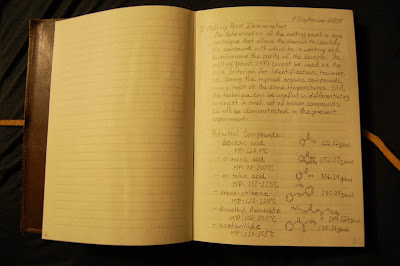 The first true page of the notebook provides an opening that demonstrates both a lack of imagination and an amateurish timidity. The style leans gingerly toward the archaic but fails to embrace any but a few examples of roundabout phrasing, which come off as awkward rather than stylish. The tone is not scientific, nor is it colloquial, but instead limply lingers in the unhappy realm of early twentieth-century educational science writing for the once-intrigued (but soon put off by stilted prose) amateur. The urge to popularize science can lead to the dampening of science's rather dry style, but this is an ill-advised path. Better to write a palatable piece from the ground up than to gnaw on dense technical rawhide to soften it for the masses. The masses deserve better, and you owe it to your sense of self-respect as a writer.
The first true page of the notebook provides an opening that demonstrates both a lack of imagination and an amateurish timidity. The style leans gingerly toward the archaic but fails to embrace any but a few examples of roundabout phrasing, which come off as awkward rather than stylish. The tone is not scientific, nor is it colloquial, but instead limply lingers in the unhappy realm of early twentieth-century educational science writing for the once-intrigued (but soon put off by stilted prose) amateur. The urge to popularize science can lead to the dampening of science's rather dry style, but this is an ill-advised path. Better to write a palatable piece from the ground up than to gnaw on dense technical rawhide to soften it for the masses. The masses deserve better, and you owe it to your sense of self-respect as a writer.In all likelihood, this page also demonstrates the peak tidiness of an ever-deteriorating formal rigidity. As the journal continues, the flourishing of creativity goes hand-in-hand with the decay of order, and I'm fairly certain the two processes are related. While the chaos never reached the heights of discord attained by some of my classmates, the handwriting loses its tone, the margins begin to wobble, and the shards of white space dwindle and wane. Enjoy the crispness of this page, if that's your cup of tea, because it won't last. In my opinion, it was a change for the better.
Transcription:
8 September 2008
I. Melting Point Determination
The determination of the melting point is one technique that allows the chemist to identify the compound with which he is working and to determine the purity of the sample. The melting point (MP) cannot be used as the sole criterion for identification, however, as, among the myriad organic compounds, many melt at the same temperatures. Still, the technique can be useful in differentiating amongst a small set of known compounds, as will be demonstrated in the present experiment.
Potential Compounds:
-benzoic acid [bond-line formula] 122.12g/mol
MP: 122.4°C
-o-anisic acid [bond-line formula] 152.15g/mol
MP: 98-103°C
-m-toluic acid [bond-line formula] 136.14g/mol
MP: 111-113°C
-trans-stilbene [bond-line formula] 180.25g/mol
MP: 122.4°C
-dimethyl fumarate [bond-line formula]
MP: 102-105°C 144.127g/mol
-acetanilide [bond-line formula] 135.17g/mol
MP: 113-115°C
[Edit: Apparently being in a foul mood is detrimental to my spelling and grammar. Just mending typos.]


